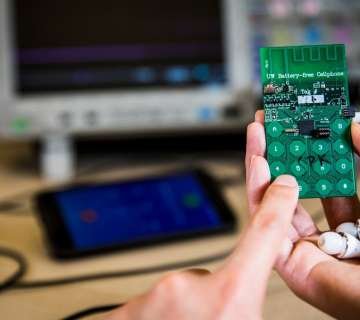
It is one of the unavoidable frustrations of modern life - phone batteries that last a day or less, leaving users stranded when a charger is out of reach.
But the end of power anxiety could be on the way after scientists developed a battery-free mobile phone that is powered by radio waves and its owner's own voice.
The low-power prototype can only make and receive calls, and lacks a touchscreen or data connection, but it could be vital in an emergency.
The phone was created by researchers at the University of Washington and consumes between two and three microwatts of energy. When within range of a base station, it can pick up on modified radio waves that give it enough power to take calls.
The phone can also transmit signals to the station through a combination of reflecting those radio wave signals back and the electromagnetic pulses generated by the vibrations of the phone's diaphragm when speaking into its microphone.
It sends a series of digital pulses to a receiver, which encodes it into a Skype call that can be placed to any number. The phone itself features few modern touches, just the 0-9 number keys, as well as * and # buttons and two action buttons for placing calls.
Because it is incapable of making and receiving signals at the same time, users must hold down a button to speak to the recipient and release it to await a reply, as if using a walkie-talkie. Without the power for a speaker, owners listen to calls using their headphones.
"This we believe is a major leap in the capability of battery-free devices and a step towards a fully functional battery-free cellphone," the researchers said.
A battery-free device remains some distance from being available to consumers - the current model only works within a few metres of a base station.
But the researchers said if they were able to use licensed mobile network frequencies, instead of the ones they were trialling the phone with, it would be able to operate at much further distances. They added that a dedicated microphone designed to create electromagnetic signals would also improve the phone's power output.
Next steps for creating a usable phone with a display would be adding a low-power e-ink display, similar to those on a Kindle, powered by radio frequencies or solar receptors.
In April, researchers in Canada showed how a phone battery with light-sensitive particles might be able to charge itself.
Timmy G.
Hi! I am a robot. I just upvoted you! I found similar content that readers might be interested in:
http://www.telegraph.co.uk/technology/2017/07/10/battery-free-mobile-phone-powered-radio-waves/
Downvoting a post can decrease pending rewards and make it less visible. Common reasons:
Submit
Brilliant, I didn't know this was in the works. Thanks for the post.
Downvoting a post can decrease pending rewards and make it less visible. Common reasons:
Submit
You welcome sir.
Downvoting a post can decrease pending rewards and make it less visible. Common reasons:
Submit